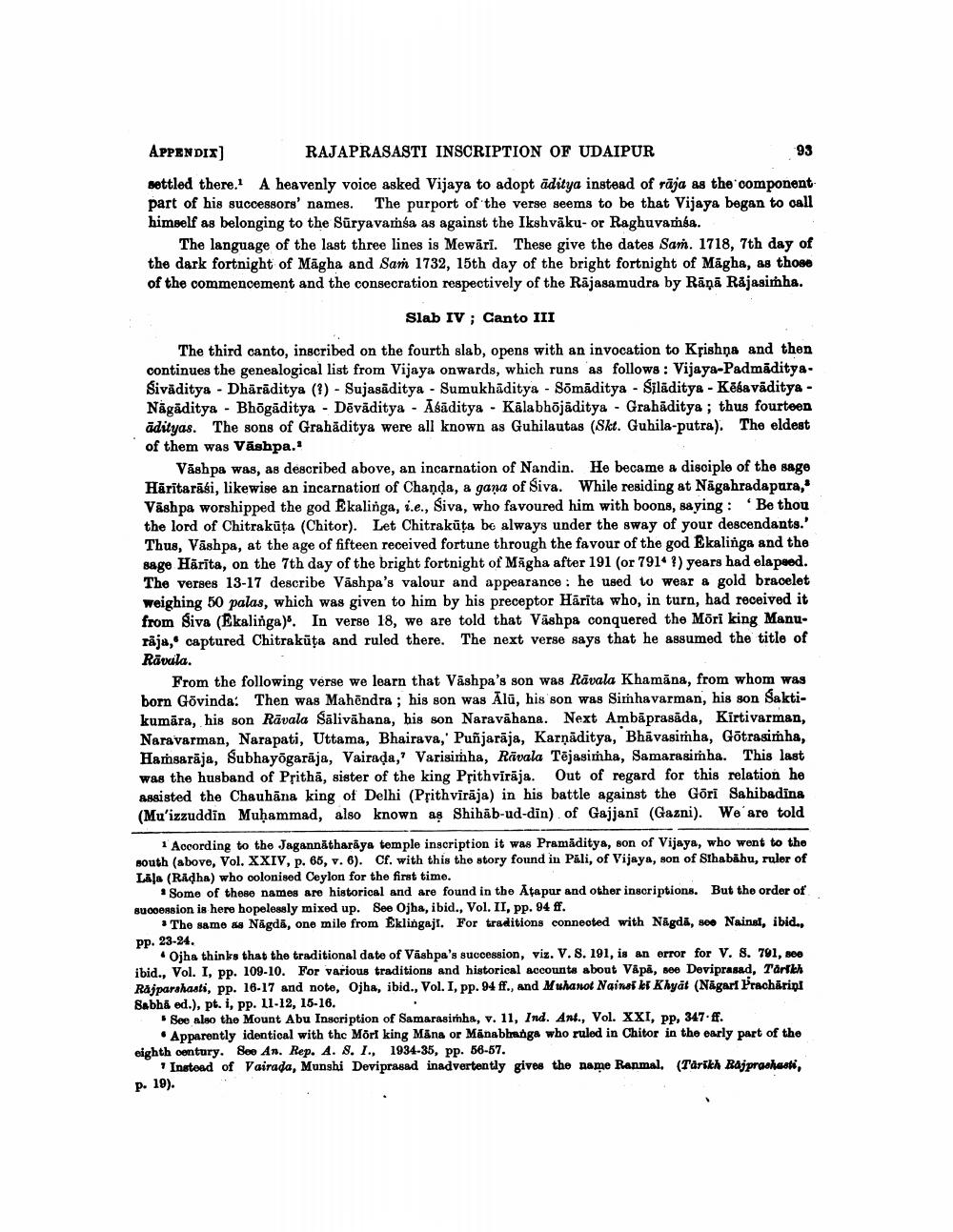________________
APPENDIX) RAJAPRASASTI INSCRIPTION OF UDAIPUR
93 settled there. A heavenly voice asked Vijaya to adopt aditya instead of rāja as the component part of his successors' names. The purport of the verse seems to be that Vijaya began to call himself as belonging to the Süryavamsa as against the Ikshvāku- or Raghuvamba.
The language of the last three lines is Mewāri. These give the dates Sam. 1718, 7th day of the dark fortnight of Māgha and San 1732, 15th day of the bright fortnight of Māgha, as those of the commencement and the consecration respectively of the Rajasamudra by Rāṇā Rājasimha.
Slab IV; Canto III
The third canto, inscribed on the fourth slab, opens with an invocation to Kpishna and then continues the genealogical list from Vijaya onwards, which runs as follows : Vijaya-Padmaditya. Sivăditya - Dhärāditya () - Sujasāditya - Sumukhāditya - Somāditya - Siladitya - Kēkavāditya - Nägāditya - Bhögāditya - Dēvåditya - Ašāditya - Kālabhõjāditya - Grahāditya ; thus fourteen ādityas. The sons of Grahăditya were all known as Guhilautas (Skt. Guhila-putra). The eldest of them was Väshpa.
Väshpa was, as described above, an incarnation of Nandin. He became a disciple of the sage Hārītarāģi, likewise an incarnation of Chanda, a gana of Siva. While residing at Nägahradapura, Väshpa worshipped the god Ekalinga, i.e., Siva, who favoured him with boons, saying: 'Be thou the lord of Chitrakūta (Chitor). Let Chitrakūta be always under the sway of your descendants.' Thus, Väshpa, at the age of fifteen received fortune through the favour of the god Ekalinga and the sage Hārīta, on the 7th day of the bright fortnight of Māgha after 191 (or 791* ?) years had elapsed. The verses 13-17 describe Väshpa's valour and appearance : he used to wear & gold bracelet weighing 50 palas, which was given to him by his preceptor Härita who, in turn, had received it from Siva (Ekalinga). In verse 18, we are told that Väshpa conquered the Möri king Manuråja, captured Chitrakūta and ruled there. The next verse says that he assumed the title of Rāvula.
From the following verse we learn that Väshpa's son was Rävala Khamāna, from whom was born Gövinda: Then was Mahindra ; his son was Alü, his son was Sirhavarman, his son Saktikumāra, his son Rävala Sālivāhana, his son Naravāhana. Next Ambaprasāda, Kirtivarman, Naravarman, Narapati, Uttama, Bhairava,' Puñjarāja, Karnāditya, Bhāvasimha, Götrasimha, Hamsarāja, Subhayőgarāja, Vairada, Varisimha, Rävala Tējasimha, Samarasimha. This last was the husband of Pritha, sister of the king Prithvirāja. Out of regard for this relation he Assisted the Chauhāna king of Delhi (Pșithvirāja) in his battle against the Göri Sahibadina (Mu'izzuddin Muhammad, also known as Shihāb-ud-din) of Gajjani (Gazni). We are told
1 According to the Jagannatharaya temple inscription it was Pramaditya, son of Vijaya, who went to the south (above, Vol. XXIV, p. 66, v. 6). Cf, with this the story found in Pali, of Vijaya, son of Sthabahu, ruler of LAS (Radha) who colonised Ceylon for the first time.
* Some of those names are historical and are found in the Atapur and other inscriptions. But the order of Bubension is here hopelessly mixed up. See Ojha, ibid., Vol. II, pp. 94 ff.
• The same as Nägda, one mile from Eklingaji. For traditions connected with Nagda, se Nainal, ibid., Pp. 23-24.
Ojha thinks that the traditional date of Väshpa's succession, viz. V.8. 191, is an error for V. 8. 791, 100 ibid.. Vol. I, pp. 109-10. For various traditions and historical accounts about Våpå, see Deviprasad, Tarikh Rajparshasti, pp. 16-17 and note, Ojha, ibid., Vol. I, pp. 94 ff., and Muhanot Nainsi ki Khyat (Nägart Prachäripl Babhä ed.), pt. 1, pp. 11-12, 15-16.
See also the Mount Abu Inscription of Samarasimha, v. 11, Ind. Ant., Vol. XXI, PP, 347. ff.
. Apparently identical with thc Mörf king Mäna or Mänabhanga who ruled in Chitor in the early part of the eighth oentury. See An. Rep. A. 8. I.. 1934-85, pp. 56-57.
Instead of Vairada, Munshi Deviprasad inadvertently gives the name Ranmal. (Tarikh Rajprashasti, p. 19).




